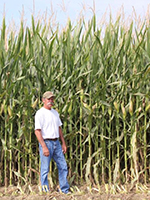
Relationships key to 45 years of custom harvesting
 With Bob Headrick, Dias & Fragoso forage consultant
With Bob Headrick, Dias & Fragoso forage consultant
A 45-year career in one industry gives a person a lot of perspective.
Bob Headrick began custom forage harvesting in California’s Central Valley in 1976. He was a “local boy” and started his business with a couple of silage trucks and a bulldozer. He bought a couple of choppers in the ‘80s and steadily grew his client base and services. In 2010, he sold his business to “competitors and friends” Dias & Fragoso. He remains a forage consultant with Dias & Fragoso today.
Although Headrick was successful in serving customers and pushing the needle on forage quality in the area, he would not describe his journey as smooth or easy. As he reflects on his career, several parallels can be drawn between the hurdles he faced and the challenges of today’s farms and custom harvesters. For Headrick, good relationships were key to overcoming obstacles.
Equipment parts and service
Downtime is a custom harvester’s greatest enemy. When equipment needs repairs, the operation isn’t running as efficiently as possible. In the early 2000s, Headrick’s local equipment dealership closed and the new ownership did not offer chopper support. Ultimately, Headrick switched brands and began working with a dealership that understood his business and could provide reliable, prompt service. Today, Dias and Fragoso’s equipment manufacturer overstocks the custom harvesters’ shops with a vast parts inventory, allowing them to repair equipment quickly, and they only pay for the parts they use.
Current supply chain issues have disrupted farms as well as dealerships. It’s not practical for every operation to maintain a large parts inventory, so off-season preventative maintenance is more valuable now than ever. Headrick emphasized the importance of working with a dealership that knows your business and can provide a high level of service when you need it.
Labor management
“Labor has always been an issue,” Headrick said.
Until the early ‘90s, Headrick was able to build his team from the local labor force. But custom harvesting is a tough job and the available labor pool became less interested in that work. Headrick was able to hire Hispanic workers, but said it was a 10-year process to get the different cultures to work together. He said one of the most important things he did as a manager was host lunches for the whole crew and force them to interact. Through casual conversation, employees got to know each other better and began performing better as a team.
Headrick also noted that you can’t hire a young employee and expect he or she will stay with your business forever. Life changes and people look for opportunities to learn and grow. For example, he said recently graduated mechanics will work on custom harvesting operations for a few years to gain practical experience. After that, they move on to new opportunities with different hours, pay, etc.
“This job is often a stepping stone,” he said.
However, Headrick has aimed to reduce employee turnover as much as possible. In addition to competitive pay, he said a manager’s attitude goes a long way in retaining employees. If an employee does something wrong, yelling rarely helps the situation. Instead, coach them through the issue and explain how they can prevent it in the future.
“Take extremely good care of employees so they stick with you,” he advised.
Customer service
Headrick cites “getting a really good client base” and “doing a good job to keep my client base” as the two biggest factors in his success. Headrick did not go after every potential customer in the area. Instead, he carefully considered who would be a good long-term business partner. Then he learned and adapted all he could to continually provide a high level of service to the customer.
For example, in his early days of custom harvesting, Headrick said harvest decisions were made based on whether the corn was dented. The adoption of the kernel processor led to a focus on starch digestibility and, with that change, Headrick began working closely with farms’ nutritionists to identify optimal harvest conditions based on cow performance, not just lab reports. In other words, Headrick doesn’t just get the job done and move on to the next farm. He thinks about how his work contributes to a farm’s long-term success.
From equipment dealers to employees to farming customers, Headrick has spent the last 45 years developing strong, lasting relationships with the people who impact the success of his business. Those relationships have helped him work through challenging times and led to a lot of good times too. A lot changes is 45 years, but, for Headrick, the value of trusted relationships always rings true.
| Category: |
Business and economics Employee management Equipment Forage Foundations Forage harvesting Silages |

